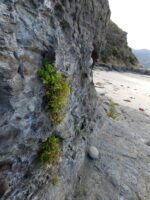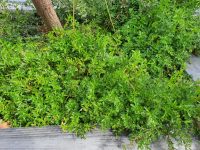Tasmanian Bush Foods project
Australian bush foods have captured the imagination of lots of Australian gardeners, and for good reason, as there are so many interesting species to explore, many of which are also very ornamental plants that fit beautifully into a garden setting. Since moving to Tasmania I have been exploring the many bush food plants that are unique to the island, as well as the various species that also occur on the mainland. I have been very fortunate to have made some good friends within the Tasmanian Aboriginal community and I am very proud to say that I am working closely with a wonderful business called Palawa Kipli. Palawa means Tasmanian Aborigine, kipli means food in palawa kani the Tasmanian Aboriginal language. The manager, Kitana Mansell is a very proud Palawa woman who is passionate about bringing Tasmanian Aboriginal culture to the fore. As well as foraging various bush foods, Kitana and I are working at the Tasmanian Aboriginal Centre’s garden near Hobart to bring as many species into cultivation as possible to supply their needs . I encourage you to follow the link above to the Palawa Kipli website to learn more about how you might share in acknowledging and learning about the Palawa culture and this modern journey that can be shared if you are in Tasmania. My current favourite species is Sea Celery (Apium prostratum), a strongly flavoured type of celery that has glossy, deep green leaves and attractive umbrella-like white flower heads and is proving very easy to grow in cultivation.
It naturally grows in most states of Australia with the exception of the N.T., and there are two different forms, one with fine leaves and one with broader leaves, which is the form I have been growing here in Tasmania. Above is a picture of a plant I found growing wild, surviving and thriving in a surprising place on one of the beautiful Tasmanian beaches. Below is it growing abundantly in the garden. Not only is this plant a useful addition to my cooking, it also looks good as well!
Long stem planting – vale Bill Hicks the genius who invented this important idea for environmental restoration
The main reason I got into media work (such as my former role as a presenter on Gardening Australia) is that I have always wanted to share and educate anyone who will listen on how we can do horticulture more sustainably and lighten our foot print on the planet. When I see what I think is a good idea I go out of my way to explore it and if I feel it has a role to play I then share it. One of the best ideas I have ever seen is the long stem planting method invented by a wonderfully clever gentleman, the late Bill Hicks, who sadly passed away earlier this year. You can read his story at this link. Bill was one of Australia’s greatest environmentalists in my opinion and his legacy lives on in many ways, not least of which is the ingenious long stem planting technique which is explained in this link. I have had enormous success with the technique over the last ten years and highly recommend it and it was especially gratifying to receive an email recently from the NSW north coast describing how they had used Bill’s technique on their property where they farm macadamia and are planting a large new garden area. There will be more on this in the next newsletter….


